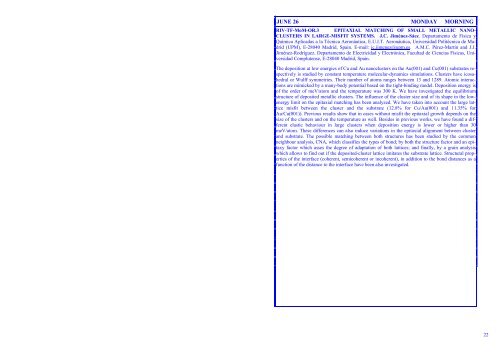Wüest M. 51 Wykes M. 82 Yamaguchi M. 17 Ybarra G. 129 Yubero F ...
Wüest M. 51 Wykes M. 82 Yamaguchi M. 17 Ybarra G. 129 Yubero F ...
Wüest M. 51 Wykes M. 82 Yamaguchi M. 17 Ybarra G. 129 Yubero F ...
Create successful ePaper yourself
Turn your PDF publications into a flip-book with our unique Google optimized e-Paper software.
JUNE 26 MONDAY MORNING<br />
RIV-TF-MoM-OR.3 EPITAXIAL MATCHING OF SMALL METALLIC NANO-<br />
CLUSTERS IN LARGE-MISFIT SYSTEMS. J.C. Jiménez-Sáez. Departamento de Física y<br />
Química Aplicadas a la Técnica Aeronáutica, E.U.I.T. Aeronáutica, Universidad Politécnica de Madrid<br />
(UPM), E-28040 Madrid, Spain. E-mail: jc.jimenez@upm.es. A.M.C. Pérez-Martín and J.J.<br />
Jiménez-Rodríguez. Departamento de Electricidad y Electrónica, Facultad de Ciencias Físicas, Universidad<br />
Complutense, E-28040 Madrid, Spain.<br />
The deposition at low energies of Cu and Au nanoclusters on the Au(001) and Cu(001) substrates respectively<br />
is studied by constant temperature molecular-dynamics simulations. Clusters have icosahedral<br />
or Wulff symmetries. Their number of atoms ranges between 13 and 1289. Atomic interactions<br />
are mimicked by a many-body potential based on the tight-binding model. Deposition energy is<br />
of the order of meV/atom and the temperature was 300 K. We have investigated the equilibrium<br />
structure of deposited metallic clusters. The influence of the cluster size and of its shape in the lowenergy<br />
limit on the epitaxial matching has been analyzed. We have taken into account the large lattice<br />
misfit between the cluster and the substrate (12.8% for Cu/Au(001) and 11.35% for<br />
Au/Cu(001)). Previous results show that in cases without misfit the epitaxial growth depends on the<br />
size of the clusters and on the temperature as well. Besides in previous works, we have found a different<br />
elastic behaviour in large clusters when deposition energy is lower or higher than 30<br />
meV/atom. These differences can also induce variations in the epitaxial alignment between cluster<br />
and substrate. The possible matching between both structures has been studied by the common<br />
neighbour analysis, CNA, which classifies the types of bond; by both the structure factor and an epitaxy<br />
factor which asses the degree of adaptation of both lattices; and finally, by a grain analysis<br />
which allows to find out if the deposited-cluster lattice imitates the substrate lattice. Structural properties<br />
of the interface (coherent, semicoherent or incoherent), in addition to the bond distances as a<br />
function of the distance to the interface have been also investigated.<br />
22
















